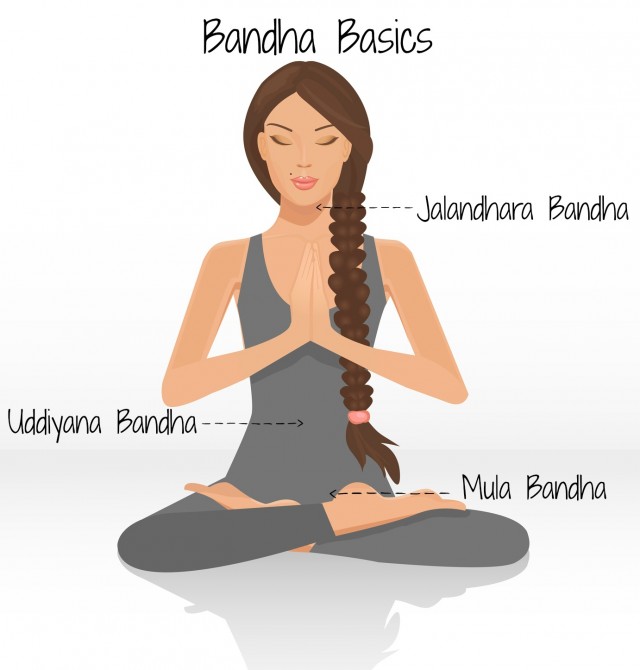Bandhas - Internal Energy Locks

The word bandha means 'to lock'. It describes well the action of bandhas; they lock the prana (body's subtle energy force). All bandhas involve muscular contraction, but the ancient yoga texts list bandhas among the most important of yoga techniques & believe that without them, the energy produced by the practice cannot be properly utilized. On a physical level, they are used to create energy centres around joints, building stability at a local level through our body, especially our spine.
Of all the locks that can be practiced in the body, there are two bandhas on which we give the most focus in Power Yoga. These are starting from the base, Mula Bandha, the root lock, and Uddiyana Bandha, the abdominal/belly lift. Working effectively with bandhas is considered an intermediate level of practice, and it can actually take students a long time to access the level of body awareness required to recruit appropriate muscle groups. It requires concentration, and deep inner awareness when activated correctly. When utilised they benefit in activating the core, help keep the practitioner safe, assist stillness during movement and stop energy (prana) leaking from the body.
Mula Bandha – To access this bandha we contract the muscles of the perineum and the pelvic floor. This contraction lifts the organs of the pelvis. These pelvic floor muscles can be referred to as the muscles you use to stop urinating. Rather than an intense contraction, we are only gently contacting them to create a delicate lock and awareness at the base of the spine (around 30% contraction). The practice of Root Lock balances the sympathetic and parasympathetic systems, eases recovery after childbirth, improves the health of the reproductive system, and increases sexual retentive power in males.
Uddiyana Bandha – This is the abdominal lift or as Uddiyana translates to fly upward. The style of Uddiyana we use is a gentle contraction of the abdominal muscles, lifting two inches below the belly button in towards the spine. It’s helpful to imagine having a frozen pea placed in the belly button and trying to gently pull the pea upward and inward toward the spine. This abdominal lock creates a stability and awareness in the core of the body protecting the lower spine by providing a natural extension and support of the lumbar vertebra. It is also very important for accessing the Ujjayi breath (Victorious Breath) in that it directs the breath into the ribcage, allowing an intercostal stretch rather than the belly filling up which creates less stability at the lower spine.
* Pregnant women should avoid strong abdominopelvic contractions.
Jalandhara Bandha - Named after the ancient yogi Jalandhari, who is credited with initiating two kings into the tradition of yoga before his renunciation of the world, this bandha is used less often than the others. When practiced correctly, it serves to lengthen and protect the back of the neck. It also localises the breath in the torso and lungs rather than the throat. Accessing this bandha in shoulder stand is a helpful way to keep the cervical spine safe.
Also engaging Jalandhara Bandha while preparing to enter poses such as Matsyendrasana (fish pose) and Ustrasana (camel), before dropping the head all the way back, makes the poses more safe. By initially drawing the chin in and upward, Jalandhara Bandha creates awareness and mindfulness before the extreme movement of letting your head hang all the way backward.
Bandha Benefits – Increased core awareness, increased core strength and stability, improved concentration, stored energy (prana) rather than leaked, reduced chance of lower back injuries, ease disorders of the reproductive and urinary systems, sexual dysfunction, back problems and recovery after birth.




